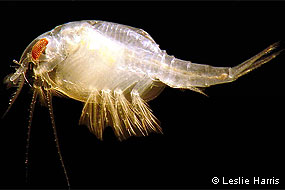|
Contact: Ben Becker, 415-464-5247

Following the lead of Great Smokey Mountains National Park, The Pacific Coast Science and Learning Center (PCSLC) at Point Reyes National Seashore began an All-Taxa Biodiversity Inventory of Tomales Bay in 2002. This collaborative (universities, museums, non-profits, stakeholders and agencies) project is cataloging all the forms of life in the bay to help guide conservation and management decisions initiated by NPS and other stakeholders. After two years of lab and fieldwork, scientists and data managers have incorporated 2015 confirmed species records into the database that can be accessed online at www.tomalesbaylife.org. Of these records, 477 species had not been documented in the bay by previous studies, and one species is a crustacean completely new to science! This new crustacean is a bright green color to blend in with the eelgrass beds of Tomales Bay. The species was first collected by Leslie Harris of the Natural History Museum of Los Angeles County, who oversees much of the marine invertebrate inventory and taxonomy work for the project. A graduate student at UCLA is currently describing and naming the new species. The discovery of this new species underscores the importance of protecting native habitats such as eelgrass beds to support previously unknown species of life that exist there. While Tomales Bay is still one of the most pristine, beautiful and biologically diverse estuaries on the California Coast, past and present human uses of the Bay and its watershed have had significant cumulative impacts on water quality, habitats, and species, resulting in a need for comprehensive watershed management. To accomplish this task, the Tomales Bay Watershed Council (www.tomalesbaywatershed.org) was formed in 2000 to promote watershed-based resource management and coordination amongst local, state and federal stakeholders. The council recommended that a detailed understanding of the species and habitats of the ecosystem be developed, thus the PCSLC began coordinating researchers, securing funding, and serving as a data repository and disseminator for the biodiversity inventory. The biodiversity inventory work has already uncovered several new management concerns. Detection of the invasive tunicate Didemnum lahillei in the bay is leading to mapping and removal efforts before the species begins to dominate the ecosystem. Researchers have also found another new sea anemone never before seen on the west coast, but believed to be a species common on the East Coast. Genetic tests will soon reveal if this is another invader or if it is a new species. Unfortunately, at least 28 of the species recently documented in the database are non-natives, of which at least 5 are deemed to be a serious threat to ecosystem health and native species. The information on their occurrence and distribution provided by the inventory will enable much more effective management and mitigation plans. The program has grown from primarily a species inventory into a multifaceted and integrated scientific research umbrella for Tomales Bay. Some of the projects currently associated with the biodiversity inventory include: native oyster restoration to create habitat and improve water quality on the bay, invasive green crab removal experiments, mapping and experimental removal of invasive species including Didemnum lahillei (a clonal tunicate that overruns native species), development of online field guides and a comprehensive on-line bibliography of all scientific literature concerning the bay, development of a water quality monitoring database for the bay, and funding several graduate student research projects each year that pertain to understanding, mapping and protecting the biodiversity of the bay. The PCSLC’s role interacting with both Park and local stakeholder scientific needs provides an excellent balance of meeting scientific and data management needs with a specialized and adaptable core facility that can provide research assistance, information management, and fundraising for rapidly changing resource information management needs. -NPS- |
Last updated: February 28, 2015
